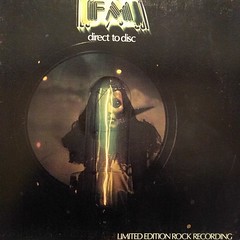
This record was released under two different titles, Direct to Disc as well as Head Room. The band has a different lineup from the first record, with Ben Mink replacing Nash the Slash. Each side contains one long suite. Side A contains Headroom, a piece with five parts: Tyra, Reflections One, Reflections Two, Real Rime, and Scarberia. If you have lived in Toronto, the last segment's title will mean something to you. Side B contains Border Crossing, broken into four segments: The First Movement, The Second Movement, The Third Movement, and The Fourth Movement.
To me, this record sounds a bit more like space rock than prog, but I guess the two genres are ultimately the same.
There have been many direct to disc recordings. The process avoids the use of tape, as the title suggests. Instead, the music is mixed live and recorded directly to a master disc. Because only a limited number of pressings could be made from one master disc, these were always produced in limited quantities. I assume that the 2013 CD edition was mastered from a vinyl copy. I suppose if there are any further vinyl copies, those would likely be mastered from this CD generation, but who knows if that will happen.
Wikipedia notes both the advantages and disadvantages of the direct-to-disc method: "Technically, direct-to-disc recording is believed to result in a more accurate, less noisy recording through the elimination of up to four generations of master tapes, overdubs, and mix downs from multi-tracked masters. The method bypasses problems inherent in recording tape: tape hiss, wow and flutter.
From the musicians' point of view, the advantages of direct-to-disc recording are a greater immediacy and interaction among the players."
And: "Although the spontaneity of performance is preserved, no overdubbing or editing is possible. It becomes more challenging for the musicians, engineers and producers, whose performances will be captured "warts and all." In the event of aborted sides, expensive lacquers are wasted and cannot be used again. According to Robert Auld of the Audio Engineering Society: "It was a notoriously difficult way to record; the musicians and all concerned had to record a complete LP side without any serious musical or technical mistakes.
Some artists maintain that musical instruments may drift out of tune: It is not possible to keep instruments in tune for the length of the LP side." [source]
Someone actually paid $100 for one of these on Discogs. I find that hard to believe.
No comments:
Post a Comment